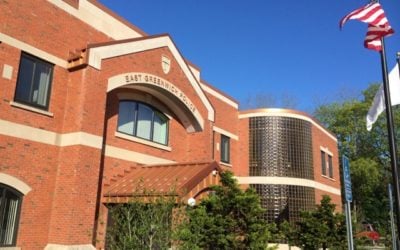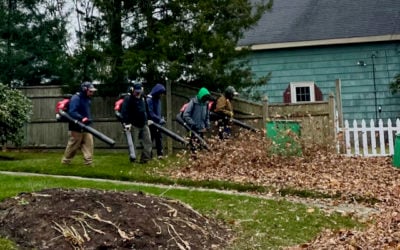Above: Monarch butterflies in the University of Delaware Botanical Garden in Newark, Del. (Douglas Tallamy/Timber Press via AP)
Some books to inform and inspire
By George D. Christie
Because much of my formal education is in entomology (BS Cornell, MS University of Riverside, California) my garden interest is a bit different. When I see holes in the leaves, I don’t reach for the pesticides, I reach for a camera. These days however, we’re seeing fewer holes in the leaves and, although we don’t miss the biting flies, we are aware that a garden without butterflies, or a vegetable garden without bumble bees, isn’t a good thing.
Fortunately, there are some wonderful books that give shape to the issue of insect and other animal and plant declines. Equally important, they’re not all doom and gloom books, they are full of simple ideas for ways we can become guardians of diversity, no matter the size of our yard or budget. The best part? They’re all available through the Ocean State Library system.
I have three clear favorites I want to mention, but I’m starting off with a fresh-of-the-presses book by Oliver Milman entitled The Insect Crisis (2022). This is perhaps the most unrelentingly discouraging book of the four, but the message is clear, insect populations around the world are in dire straits. Population crashes of 75, 85, even 90+ percent have been recorded in the last several decades. Even relatively pristine tropical forests have seen stunning declines, although no obvious threats were visible. Climate change, pesticide use, and habitat destruction combine to create conditions under which many species of insects simply disappear. Amidst the loss, however, two important points stand out.
First, insects are very resilient (as we know from trying to keep ants out of the TV room!). Several recent projects cited by Milman show that simply eliminating pesticide use on a property can have a significant positive impact on insect diversity. Second, even small gardens can provide “islands” of habitat for insects. A single pot of black-eyed Susans isn’t going to save the world, but it can be a welcome source of pollen for a solitary bee. Milman doesn’t mince words, but neither does he concede the match, we can create a winning world.
If I only had space to recommend one book, I wouldn’t hesitate. Doug Tallamy’s Bringing Nature Home (2007) remains the best single read for why we should plant as many native plants as possible. Working in residential landscapes in the mid-Atlantic region, Tallamy and his graduate students conclusively proved native plants produce more biodiversity than do non-native plants. Meaning more chickadees at your feeders. As he concisely states, “It is now within the power of individual gardeners to do something that we all dream of doing: to make a difference.” It’s time to return to sharing our garden with the flora and fauna that evolved to live here. He admits his is not a how-to book, but he does include information on host plant-insect relationships and native plants that can be integrated easily into the garden.
Sue Reed and Ginny Stibolt’s Climate-wise Landscaping is a how-to book, and a great one at that. Their strategy is simple: provide an array of steps a property-owner can take to transform their land into an easier-to-manage, more resilient ecosystem. As they say, “This book is a tool for anyone who wants to be part of the solution to climate change.” Some of the steps are simple—mow less frequently, encourage native plants that are pre-adapted to local rainfall patterns, stop spraying pesticides everywhere all the time. Others can be more challenging—reduce the area devoted to lawn, remove known invasive plants, install rain barrels. No one step in a single garden will halt the climate change process already occurring, but as more and more people choose to take more and more steps towards ecosystem resiliency, the positive effects will be obvious. This is an optimistic book. We can’t save it all, but we can save a great deal.
We Are the Ark, by Mary Reynolds (2022) is an intensely personal work of self-reflection and growth. Hers is not a scientific tome, but rather a call to action. She writes of witnessing the wild creatures scurrying through her yard only to discover, when she goes to see why, that an acre of wildly tangled vegetation nearby was being bulldozed for a building project. Having been a garden designer herself for years, she knew she was watching something that she herself had planned for many times—the elimination of the homes of so many of the very creatures she loved. What, she asked, was she thinking!? From this epiphany she developed to concept of gardens as arks, as places released from the bondage of mowers, blowers and sprayers, where the landscape architect’s designed line gives way to the chaos of life and where native plants and the animals they support are nurtured, not butchered.
In the arks she envisions, half or more of one’s property is allowed to regenerate itself (with help if needed) into a more-natural environment perfect for encouraging native wildlife. She understands the change she is asking – to view a garter snake as a good neighbor – can be difficult, but it is essential if we are to have a natural future. Thinking of being surrounded by “my” wildflowers, I find her words to be beautifully true, “There is so much joy, hope, satisfaction, and belonging available in restoring land to its truth, to its wild ways.”
A common theme of all these books is recreating more-natural habitats in our gardens in order to improve biodiversity and lessen the impacts of climate change. Each in their own way also understands we cannot go back to some ideal pristine past, not only because so much has changed, but because no such past ever really existed. The first hunter-gatherers who entered the New England region discovered there was work to do, if one wanted a comfortable life here. But all the authors stress we must go forward, and the path we take is not a given, it is a choice. All chose the path of sometimes hard, but always richly rewarding, work. It is a path deserving of many footprints.






 Subscribe
Subscribe
I am a follower of Doug Tallamy’s ideas and plans and have taken many of his ideas to heart. He is involved in the Home Grown National Park effort of which I am a member. Doug is a very interesting speaker and I take in one of his presentations whenever I can. Thank you for the book recommendations.
So glad to hear you’ve taken Doug’s word to heart. He and his students have really provided the strong evidence for the value of native plants we needed to advance modern gardens past the fruitless pasttime of trying to imitate the gardens of 19th century european nobility.
Anyone who cares about the world they hand over to their children and grandchildren should read every book and article Doug Tallamy has published. I second the recommendation of his lecturing talent.
Agreed.
And I just found “Lawns to Meadows” by Owen Wormser over the weekend. There is a treasure drove of great thought on native lanscape design for everyone out there.